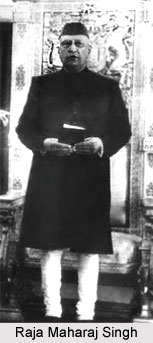 Raja Maharaj Singh, also known as Raja Sir Maharaj Singh, CIE, CStJ, became the first Indian Governor of Bombay Presidency in the year 1948, after the nation achieved independence from the rule of the British Empire in India. Singh was born on 17 May 1878 as the son of Raja Harnam Singh of the Kapurthala royal family. He completed his education from Harrow School. Later he studied MA from Balliol College in Oxford. In the year 1902, he was called to Bar by the Middle Temple. Raja Sir Maharaj Singh was initially appointed as the Deputy Collector of United Provinces and later held many positions in the government of India. In the year 1941, was elected the chancellor of Lucknow University. He also served as the Prime Minister of Kashmir for a brief period.
Raja Maharaj Singh, also known as Raja Sir Maharaj Singh, CIE, CStJ, became the first Indian Governor of Bombay Presidency in the year 1948, after the nation achieved independence from the rule of the British Empire in India. Singh was born on 17 May 1878 as the son of Raja Harnam Singh of the Kapurthala royal family. He completed his education from Harrow School. Later he studied MA from Balliol College in Oxford. In the year 1902, he was called to Bar by the Middle Temple. Raja Sir Maharaj Singh was initially appointed as the Deputy Collector of United Provinces and later held many positions in the government of India. In the year 1941, was elected the chancellor of Lucknow University. He also served as the Prime Minister of Kashmir for a brief period.
Raja Maharaj Singh as Governor of Bombay Presidency
Raja Maharaj Singh was appointed as the Governor of Bombay Province on 6 January 1948, after the withdrawal of the British administration and the Partition of India. Bombay State was one of the erstwhile states of India. During the British supremacy, regions in the western coast of India were incorporated as a part of the Bombay Presidency. Bombay Presidency was one of the three Presidencies in British India, the other 2 including Bengal Presidency and Madras Presidency. After the nation gained independence in the year 1947, most of the former princely states of India, including the Deccan states and the Gujarat states, were amalgamated with the Bombay Presidency, which was reorganized into Bombay State in the year 1950.
On 1st November 1956, the State of Bombay was enlarged eastward to include the Marathwada region of Hyderabad State, the Vidarbha region of southern Madhya Pradesh, Saurashtra and Kutch. Later on 1 May 1960, Bombay State was dissolved with the creation of the modern Indian states of Gujarat and Maharashtra. Singh served in office till 30 May 1952 and was succeeded by Sir Girija Shankar Bajpai, KCSI, KBE, CIE, as the Governor of Bombay State.
Later Life of Raja Maharaj Singh
Raja Maharaj Singh acted as the captain of the Bombay Governor`s XI cricket team against a touring Commonwealth XI on 25 November 1950, when he was 72 years old. Raja Sir Maharaj Singh was knighted with the Companion of the Most Eminent Order of the Indian Empire (CIE) in the year 1915 and Commander of the Most Venerable Order of the Hospital of Saint John of Jerusalem (CStJ) in 1933.
Personal Life of Raja Maharaj Singh
Raja Maharaj Singh was married with Gunwati Maya Das of Ferozepore and the couple had a daughter and 2 sons, namely Prem Maharaj Singh, Kanwar Mahindar Singh and Raja Ranbir Singh.
Titles of Raja Maharaj Singh
Raja Sir Maharaj Singh, CIE, CStJ held several titles through out his career, which are mentioned below-
* Kunwar Maharaj Singh (1878- 1915)
* Kunwar Maharaj Singh, CIE (1915- 1932)
* Raja Maharaj Singh, CIE (1932- 1933)
* Raja Sir Maharaj Singh, CIE (1933- 1937)
* Raja Sir Maharaj Singh, CIE, CStJ (1937- 1959)
* His Excellency Sri Sir Maharaj Singh, CIE, CStJ, Governor of the State of Bombay (1948- 1952)
Honours of Raja Maharaj Singh
Raja Maharaj Singh was honoured a number of times by the British Government and the Government of India. These are discussed as follows-
* Companion of the Order of the Indian Empire- CIE (1915)
* Knight Bachelor (1933)
* King George V Silver Jubilee Medal (1935)
* Commander of the Order of St John- CStJ (1937)
* King George VI Coronation Medal (1937)
* Indian Independence Medal (1947)



















